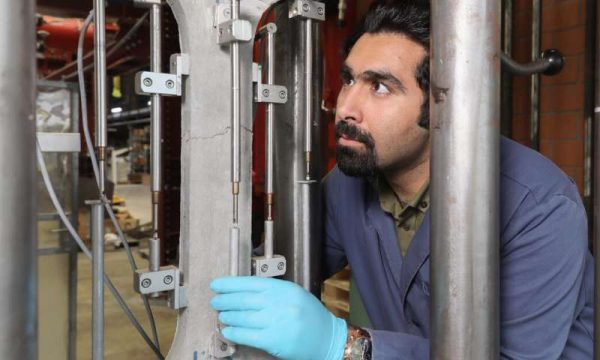A MORE SUSTAINABLE MATERIAL TO REINFORCE CONCRETE STRUCTURES
The next generation of ultra high-performance fibre-reinforced concrete (UHPFRC) has just been created at EPFL. The new material will be used to strengthen and to extend the life span of bridges and other structures – both new and old. What’s more, manufacturing this material releases 60–70% less CO2 than the previous generation of fibre-reinforced concrete.
The construction industry accounts for around 40% of global CO2 emissions, much of which can be attributed to the manufacture of concrete. And countries like Switzerland, where concrete structures have flourished since the 1960s, now face the task of maintaining these structures to ensure they remain safe far into the future. This is a daunting challenge with both environmental and technical considerations.
EPFL’s Structural Maintenance and Safety Laboratory (MCS), headed by Eugen Brühwiler, has built up cutting-edge expertise in this field over the past 25 years. The MCS specialises in developing more eco-friendly concrete, and carrying out increasingly sophisticated, largely monitoring-based, assessments of existing structures, such as road and rail bridges in Switzerland and around the world.
For his Ph.D. thesis, MCS researcher Amir Hajiesmaeili sought to develop the next generation of ultra high-performance fibre-reinforced concrete (UHPFRC). His aim was to develop a material that retains the mechanical properties found in today’s concrete, but without the steel fibres. The UHPFRC that Hajiesmaeili came up with is 10% lighter than other fibre-reinforced concrete, and its environmental impact is 60–70% lower. This new material is so effective that the first tech transfer will take place in 2020, when it will be used to reinforce a bridge.
After completing a Master’s degree in civil engineering at the University of Tehran, he came to EPFL to do his Ph.D. as part of the Swiss National Science Foundation’s NRP “Energy Turnaround” (NRP 70) project. He spent nearly four years “cooking” at EPFL. Each week he would prepare various combinations of powders in a scientific way, according to a novel comprehensive packing model that they developed in MCS and stir them up in a mixer. He would then run his samples through various strength and tensile tests and refine his calculations. His aim was to produce a new UHPFRC that is just as strong as the one currently used in the construction industry but that produces less CO2.
“After three years of trial-and-error, we finally found the right recipe – one that also meets stringent building standards,” says Hajiesmaeili. How did he do it? Instead of steel fibre, he used a very stiff synthetic polyethylene fibre that adheres well to the cement matrix. He also replaced half the cement with limestone, a material widely available around the world. “The trick was to find a material that’s very strong and produces the right consistency.”
For the past 15 years, first-generation UHPFRC has been used to reinforce bridges to make them more sustainable, thanks to a technology developed in Switzerland and exported abroad. Its carbon footprint is already lower than that of conventional reinforced concrete.
“With this material, we can add value to age-old structures by ensuring they will last for a long, long time,” says Brühwiler, whose lab has already overseen the structural reinforcement of over 100 bridges and buildings in Switzerland. “This solution is also much more financially and environmentally sound than razing and rebuilding existing structures like bridges and historical monuments.”https://phys.org/news/2019-11-sustainable-material-concrete.html






